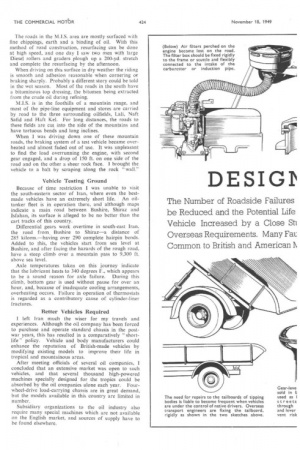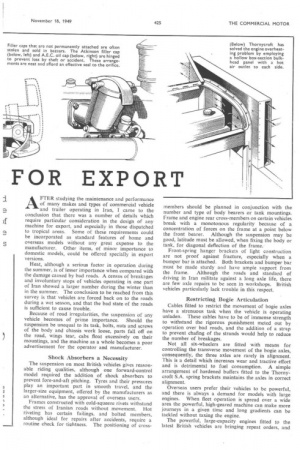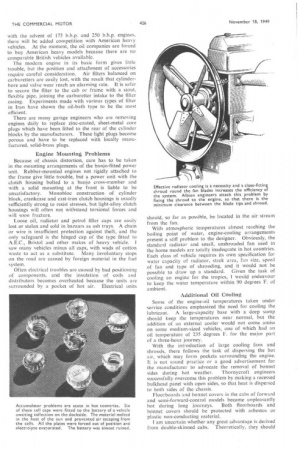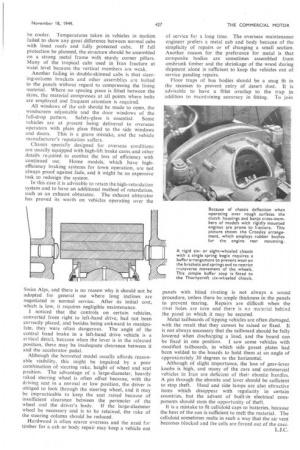DESIGIs
Page 46

Page 47

Page 48

Page 49

Page 50

If you've noticed an error in this article please click here to report it so we can fix it.
The roads in the 1%/1.1.S. area are mostly surfaced with fine chippings, earth and a binding of oil. With this method of road construction, resurfacing can be done at high speed, and one day I saw two men with large Diesel rollers and graders plough up a 200-yd. stretch and complete the resurfacing by the afternoon.
When driving on this surface in dry weather the riding is smooth and adhesion reasonable when cornering or braking sharply. Probably a different story could be told in the wet season. Most of the roads in the south have a bituminous top dressing, the bitumen being extracted from the crude oil during refining.
M.I.S. is in the foothills of a mountain range, and most of the pipe-line equipment and stores are carried by road to the three surrounding oilfields, Lali, Naft Safid and Haft Kel. For long distances, the roads to these fields are cut into the side of the mountains and have tortuous bends and long inclines.
When I was driving down one of these mountain roads, the braking system of a test vehicle became overheated and almost faded out of use. It was unpleasant to find the load overrunning the engine, with second gear engaged, and a drop of 150 ft. on one side of the road and on the other a sheer rock face. I brought the vehicle to a halt by scraping along the rock "wall."
Vehicle Testing Ground Because of time restriction I was unable to visit the south-eastern sector of Jran, where even the bestmade vehicles have an extremely short life. An oiltanker fleet is in operation there, and although maps indicate a main road between Bushire, Shiraz and Isfahan, its surface is alleged to be no better than the cart tracks of this country.
Differential gears work overtime in south-east Iran, the road from, Bushire to Shiraz—a distance of 285 kilorns.—having over 290 complete hairpin bends. Added to this, the vehicles start from sea level at Bushire, and after facing the hazards of the rough road, have a steep climb over a mountain pass to 9.300 ft. above sea level.
Axle temperatures taken on this journey indicate that the lubricant heats to 340 degrees F., which appears to be a sound reason for axle failure. During this climb, bottom gear is used without pause for over an hour, and, because of inadequate cooling arrangements, overheating occurs. Failure in operation of thermostats is regarded as a contributory cause of cylinder-liner fractures.
Better Vehicles Required
left Iran much the wiser for my travels and experiences. Although the oil company has been forced to purchase and operate standard chassis in the postwar years, this has resulted in a comparatively " shor tlife " policy. Vehicle and body manufacturers could enhance the reputation of British-made vehicles by modifying existing models to improve their life in tropical and mountainous areas.
After meeting officials of several oil companies, I concluded that an extensive market was open to such vehicles, and that several thousand high-powered machines specially designed for the tropics could be absorbed by the oil companies alone each year. Fourwheel-drive load-carrying chassis are in great demand, but the models available in this country are limited in number.
Subsidiary organizations to the oil industry also require many special machines which are not available on the English market, and sources of supply have to be found elsewhere.
The need for repairs to the tailboards of tipping bodies is liable to become frequent when vehicles are under the control of native drivers. Overseas transport engineers are fixing the tailboard, rigidly as shown in the two sketches above.
AFTER studying the maintenance and performance of many makes and types of commercial vehicle and trailer operating in Iran, I came to the conclusion that there was a number of details which require particular consideration in the design of any machine for export, and especially in those dispatched to tropical areas. Some of these requirements could be incorporated as standard features of home and overseas models without any great expense to the manufacturer. Other items, of minor importance to domestic models, could be offered specially in export versions.
Heat, although a serious factor in operation during the summer, is of lesser importance when compared with the damage caused by bad roads. A census of breakages and involuntary stops of vehicles operating in one part of Iran showed a larger number during the winter than in the summer. The conclusion to be reached from this survey is that vehicles are forced back on to the roads during a wet season, and that the bad state of the roads is sufficient to cause trouble.
Because of road irregularities, the suspension of any vehicle becomes of prime importance. Should the suspension be unequal to its task, bolts, nuts and screws of the body and chassis work loose, parts fall off on the road, wings tear, cabs float excessively on their mountings, and the machine as a whole becomes a poor advertisement for the operator and manufacturer.
Shock Absorbers a Necessity The suspension on most British vehicles gives reasonable riding qualities, although one forward-control model required the addition of shock absorbers to prevent fore-and-aft pitching. Tyres and their pressures play an important part in smooth travel, and the larger-size equipment, offered by the manufacturers as an alternative, has the approval of overseas users.
Frames constructed with cold-squeeze rivets withstand the stress of Iranian roads without movement. Hot riveting has certain failings, and bolted members, although ideal for repairs after accidents, require a routine check for tiahtness. The positioning of cross
members should be planned in conjunction with the number and type of body bearers or tank mountings. Frame and engine rear cross-members on certain vehicles break with a monotonous regularity because of a concentration of forces on the frame at a point below the front bearer. Although the suspension may be good, latitude must be allowed, when fixing the body or tank, for diagonal deflection of the frame.• Front-spring hanger brackets of light construction are not proof against fracture, especially when a bumper bar is attached. Both brackets and bumper bar must be made sturdy and have ample support from the frame. Although the roads and standard of driving in Iran militate against a long axle life, there are few axle repairs to be seen in workshops. British vehicles particularly lack trouble in this respect.
Restricting Bogie Articulation Cables fitted to restrict the movement of bogie axles have a strenuous task when the vehicle is operating unladen. These cables have to be of immense strength to withstand the rigorous punishment meted out by operation over bad roads, and the addition of a strap to prevent chafing of the strands would help to reduce the number of breakages.
Not all six-wheelers are fitted with means for controlling the transverse movement of the bogie axles, consequently, the three axles are rarely in alignment. This is a detail which increases wear and tractive effort and is detrimental to fuel consumption, A simple arrangement of hardened buffers fitted to the Thornycroft S.A. spring brackets maintains the axles in correct alignment.
Overseas users prefer their vehicles to be powerful, and there is always a demand for models with large engines. When fleet operation is spread over a wide area the powerful, high-geared machine can make more journeys in a given time and long gradients can be tackled without taxing the engine.
The powerful, large-capacity engines fitted to the latest British vehicles are bringing repeat orders, and with the advent of 175 b.h.p. and 250 b.h.p. engines, there will be added competition with American heavy vehicles. At the moment, the oil companies are forced to buy American heavy models because there are no comparable British vehicles available.
The modern engine in its basic form gives little trouble, but the position and attachment of accessories require careful consideration. Air filters balanced on carburetters are easily lost, with the result that cylinderbore and valve wear reach an alarming rate. It is safer to secure the filter to the cab or frame with a stout, flexible pipe, joining the carburetter intake to the filter casing. Experiments made with various types of filter in Iran have shown the oil-bath type to be the most efficient.
There are many garage engineers who are removing engines daily to replace zinc-coated, sheet-metal core plugs which have been fitted to the rear of the cylinder blocks by the manufacturers. These light plugs become porous and have to be replaced with locally manufactured, solid-brass plugs.
Engine Mounting Problems Because of chassis distortion, care has to be taken in the mounting arrangements of the banjo-fitted power unit. Rubber-mounted engines not rigidly attached to the frame give little trouble, but a power unit with the clutch housing bolted to a banjo cross-member and with a solid mounting at the front is liable to be unsatisfactory. Monobloc construction of cylinder block, crankcase and cast-iron clutch housings is usually sufficiently strong to resist stresses, but light-alloy clutch housings will often not withstand torsional forces and will soon fracture.
Loose oil, radiator and petrol tiller caps are easily lost or stolen and sold in bazaars as ash trays. A chain or wire is insufficient protection against theft, and the only safeguard is the hinged cap of the type fitted to A.E.C., Bristol and other makes of heavy vehicle. I saw many vehicles minus all caps, with wads of cotton waste to act as a substitute. Many involuntary stops on the road are caused by foreign material in the fuel system.
Often electrical troubles are caused by bad positioning of components, and the insulation of coils and distributors becomes overheated because the units are surrounded by a pocket of hot air. Electrical units should, so far as possible, be located in the air stream from the fan.
With atmospheric temperatures almost reaching the boiling point of water, engine-cooling arrangements present a stiff problem to the designer. Obviously, the standard radiator and small, unshrouded fan used in the home models are totally inadequate in hot countries. Each class of vehicle requires its own specification for water capacity of radiator, stack area, fan size, speed of fan and type of shrouding, and it would not be possible to draw up a standard. Given the task of cooling an engine for the tropics, I would endeavour to keep the water temperature within 90 degrees F. of ambient.
Additional Oil Cooling Some of the engine-oil temperatures taken under service conditions emphasized the need for cooling the lubricant. A large-capacity base with a deep sump should keep the temperatures near normal, but the addition of an external cooler would not come amiss on some medium-sized vehicles, one of which had an oil temperature of 235 degrees F. for the major part of a three-hour journey.
With the introduction of large cooling fans and shrouds, there follows the task of dispersing the hot air, which may form pockets surrounding the engine. It is not sound practice or a good advertisement for the manufacturer to advocate the removal of bonnet sides during hot weather. Thornycroft engineers successfully overcome this problem by making a recessed bulkhead panel with open sides, so that heat is dispersed to both sides of the chassis.
Floorboards and bonnet covers in the cabs of forward and semi-forward-control models became unpleasantly hot during long journeys. Both floorboards and bonnet covers should be protected with asbestos or plastic non-conducting material.
I am uncertain whether any great advantage is derived from double-skinned cabs. Theoretically, they should be cooler. Temperatures taken in vehicles in motion failed to show any great difference between normal cabs with lined roofs and fully protected cabs. If full protection be planned, the structure should be assembled on a strong metal frame with sturdy corner pillars. Many of the tropical cabs used in Iran fracture at waist level because the vertical members are weak.
Another failing in double-skinned cabs is that steering-column brackets and other assemblies are bolted to the panels without regard to compressing the lining material. Where no spacing piece is fitted between the skins, the material compresses at all points where bolts are employed and frequent attention is required. All windows of the cab should be made to open, the windscreen adjustable and the door windows of the full-drop pattern. Safety-glass is essential. Some vehicles are at present being delivered to overseas operators with plain glass fitted to the side windows and doors. This is a grave mistake, and the vehicle manufacturer's reputation suffers. Chassis specially designed for overseas conditions are usually equipped with high-lift brake cams and other details required to combat the loss of efficiency with continued use. Home models, which have highefficiency braking systems for town operation, are not always proof against fade, and it might be an expensive task to redesign the system. In this case it is advisable to retain the high-retardation system and to have an additional method of retardation, such as an exhaust obturator. The exhaust obturator has proved its worth on vehicles operating over the Swiss Alps, and there is no reason why it should not be adopted for general use where long inclines are negotiated in normal service. After its initial cost, which is low, it requires negligible maintenance. I noticed that the controls on certain vehicles, converted from right to left-hand drive, had not been correctly placed, and besides being awkward to manipulate, they were often dangerous. The angle of the central hand brake in a left-hand drive vehicle is a critical detail, because when the lever is in the released position, there may be inadequate clearance between it and the accelerator pedal. Although the bonneted model usually affords reasonable visibility, this might be impaired by a poor combination of steering rake, height of wheel and scat position. The advantage of a large-diameter, heavily raked steering wheel is often offset because, with the driving seat in a normal or low position, the driver is obliged to look through the steering wheel, and it may be impracticable to keep the seat raised because of insufficient clearance between the perimeter of the wheel and the driver's body. If the large-diameter wheel be necessary and is to be retained, the rake of the steering column should be reduced. Hardwood is often scarce overseas and the need for timber for a cab or body repair may keep a vehicle out of service for a long time. The overseas maintenance engineer prefers a metal cab and body because of the simplicity of repairs or of changing a small section. Another reason for the preference for metal is that composite bodies are sometimes assembled from unshrunk timber and the shrinkage of the wood during shipment alone is sufficient to keep the vehicles out of service pending repairs. Floor traps of bus bodies should be a snug fit in the recesses to prevent entry of desert dust. It is advisable to have a fillet overlap to the trap in addition to maintaining accuracy in fitting. To join panels with blind riveting is not always a sound procedure, unless there be ample thickness in the panels to prevent tearing. Repairs are difficult when the rivet holes are torn and there is no material behind the panel to which it may be secured. Metal tailboards of tipping vehicles are often damaged, with the result that they cannot be raised or fixed. It is not always necessary that the tailboard should be fully lowered when discharging a load, and the board can be fixed in one position. I saw some vehicles with modified tailboards, in which side gusset plates had been welded to the boards to hold them at an angle of approximately 30 degrees to the horizontal. Although of slight importance, the loss of gear-lever knobs is high, and many of the cars and commercial vehicles in Iran are deficient of their ebonite handles. A pin through the ebonite and lever should be sufficient to stop theft. Head and side lamps are also attractive items which disappear with regularity in certain countries, but the advent of built-in electrical components should stem the opportunity of theft. It is a mistake to fit celluloid caps to batteries, because the heat of the sun is sufficient to melt the material. The celluloid sometimes melts in such a way that the air vent becomes blocked and the cells are forced out of the case. ping lorries or articulated outfits. It takes another three days to teach drivers on steering-column gear levers. Another section of the school is devoted to instructing drivers on specialized vehicles. Potential drivers of Coventry Climax fork-lift trucks were being tested during my visit, the pass-out trial being to stack six layers of bitumen drums to a height of 15 ft.
Driver training, like other training schemes of the oil company, involves a high proportion of wastage after the period of instruction is completed. Conscription into the Iranian armed forces has to be taken into consideration, whilst other employees leave the oil company to take up alternative employment in the north, where the climate is more moderate during the summer.
Trade and adult trainees are subjected to a basic period of instruction. The class-work training includes teaching the names of tools by sketches, technical English, arithmetic and safety precautions. This tuition is followed by a practical use of hand tools and tests for accuracy in sawing, filing, drilling and tapping.
Artisan apprentices and trade trainees start their works training after leaving school, and combine their practical experience with part-time classes at the technical institute. After completing their period of training they are given a trade test, and qualify as high




























































































